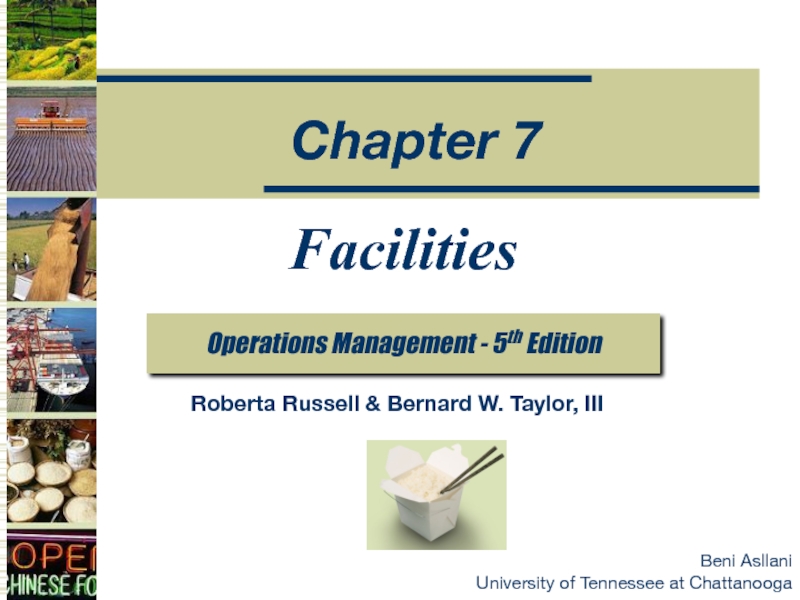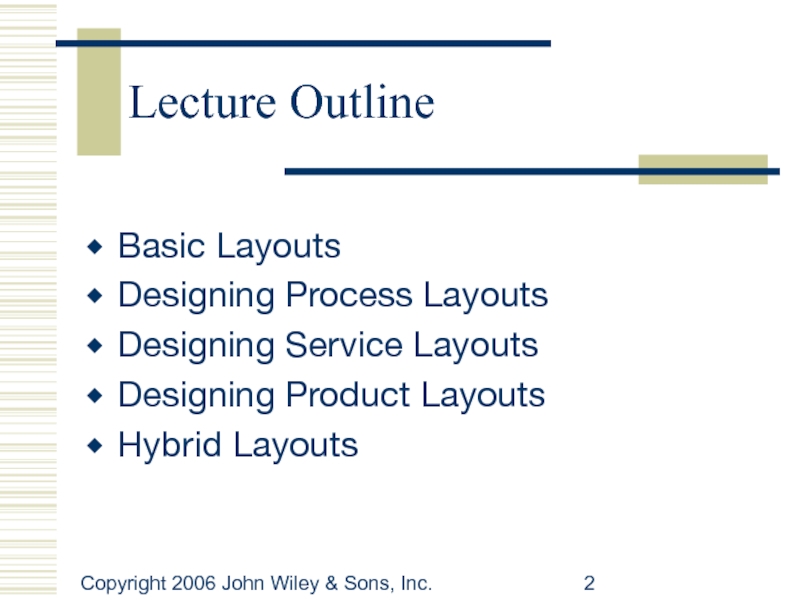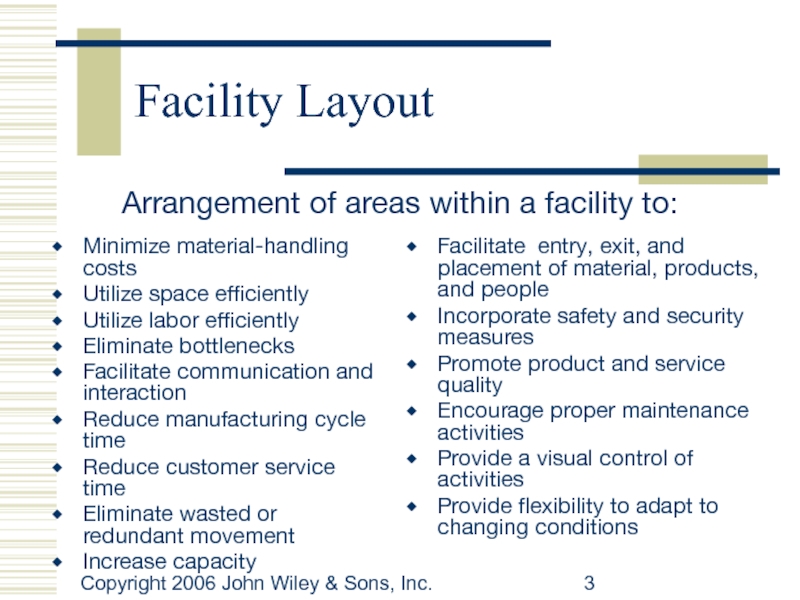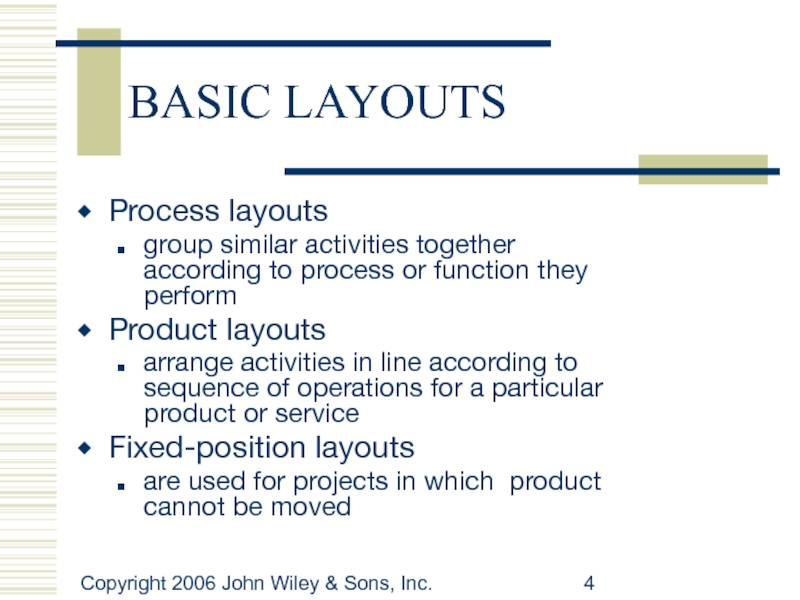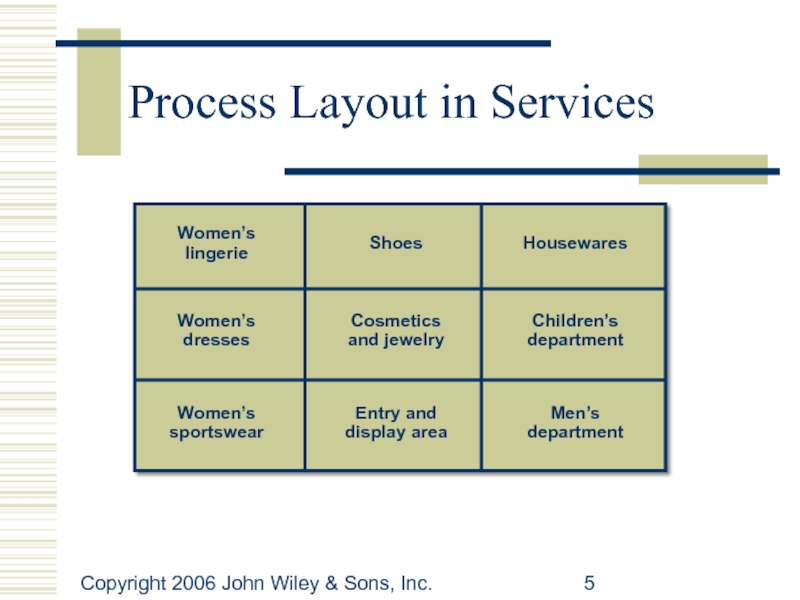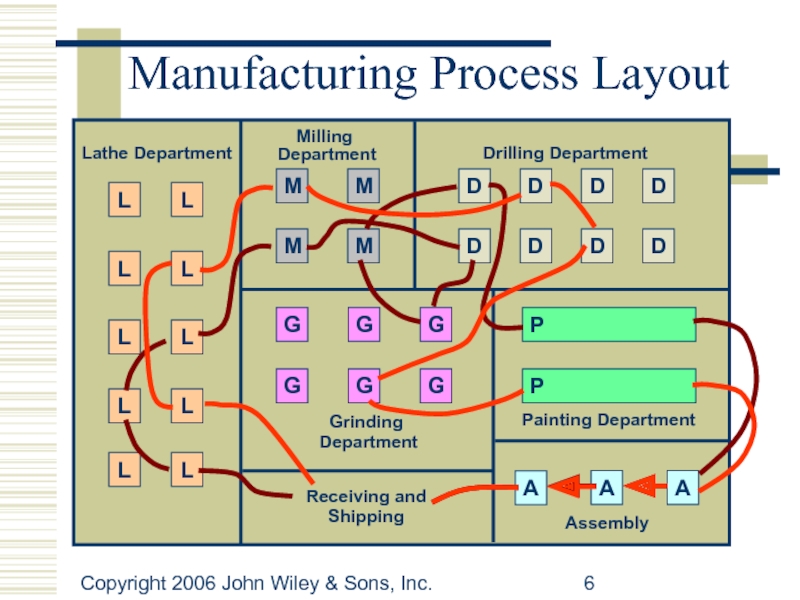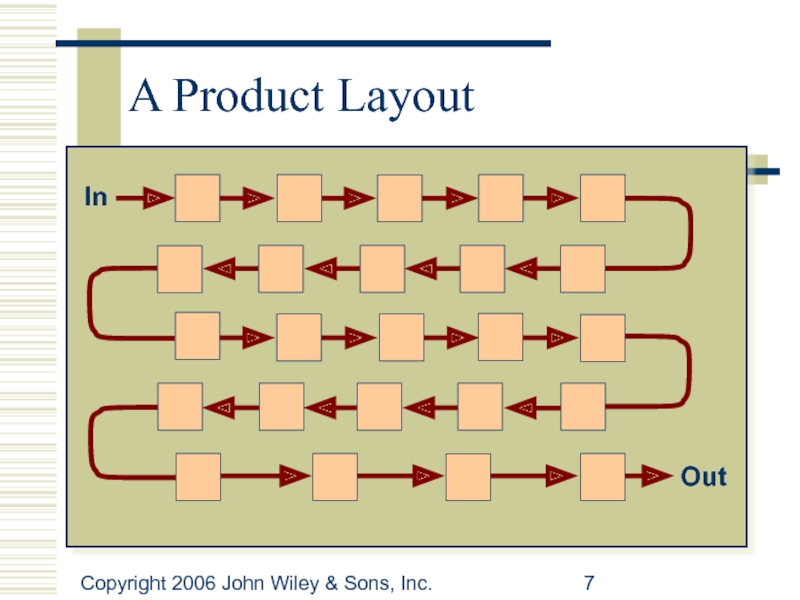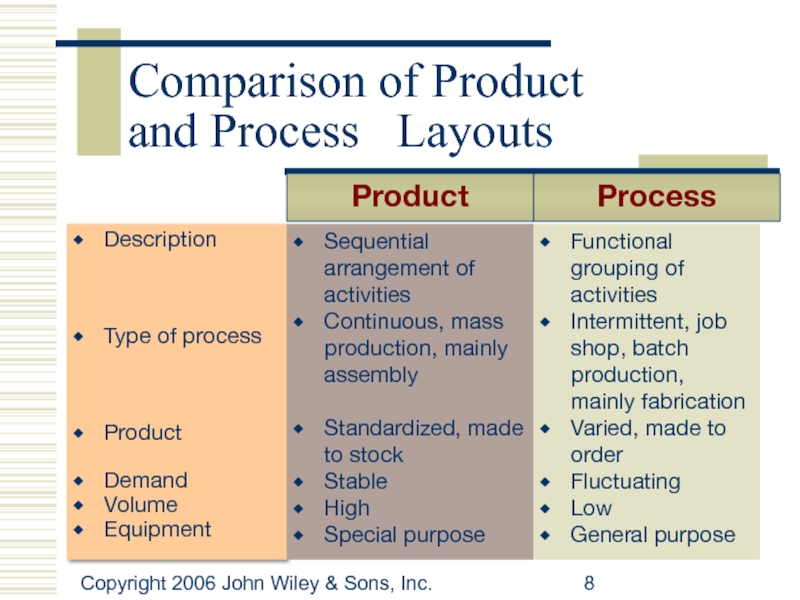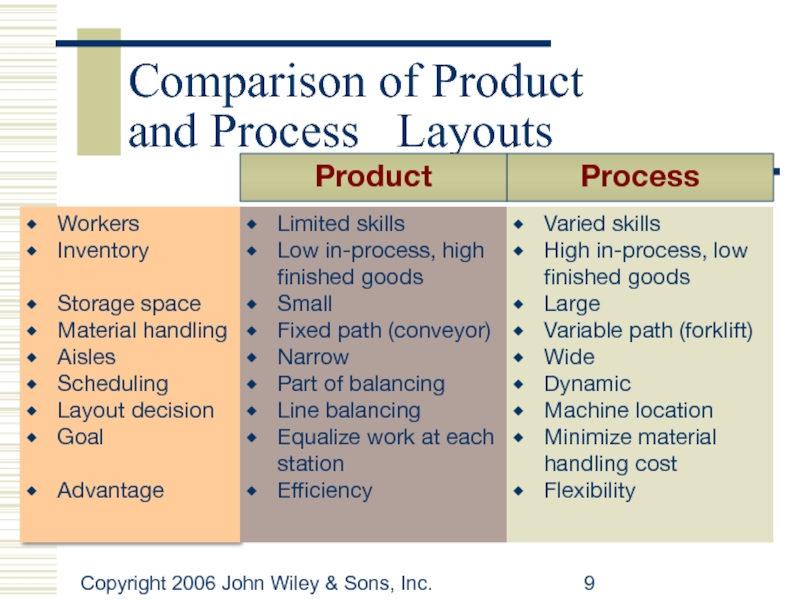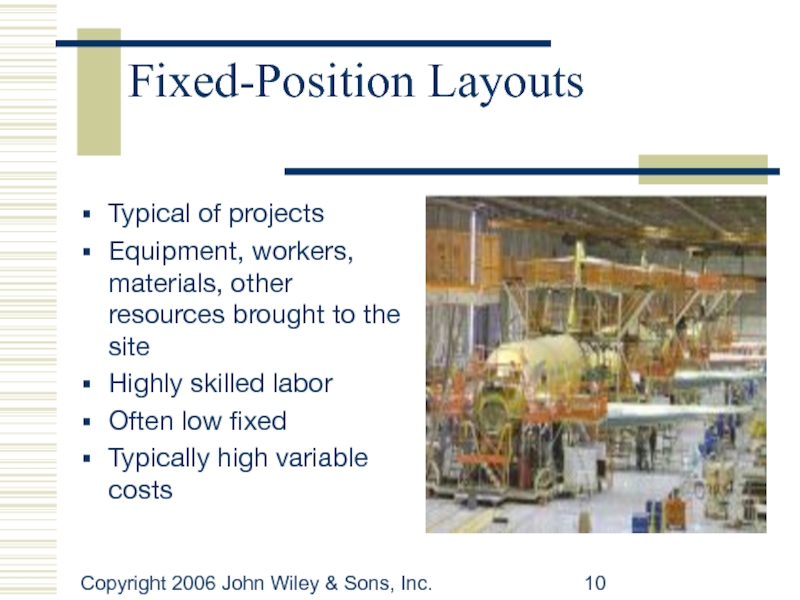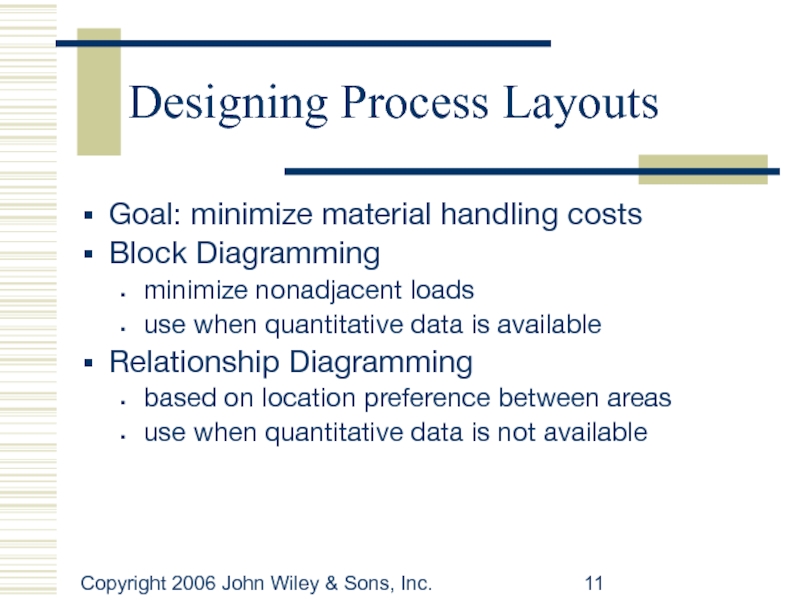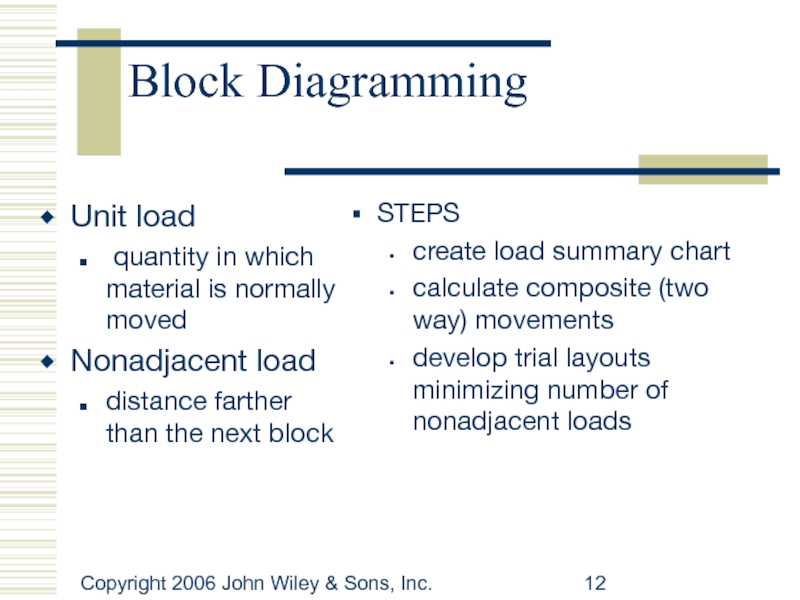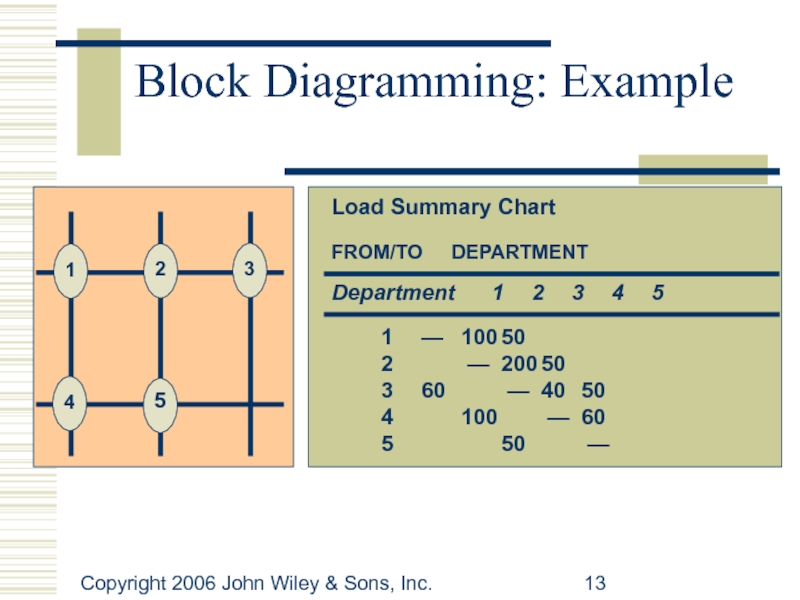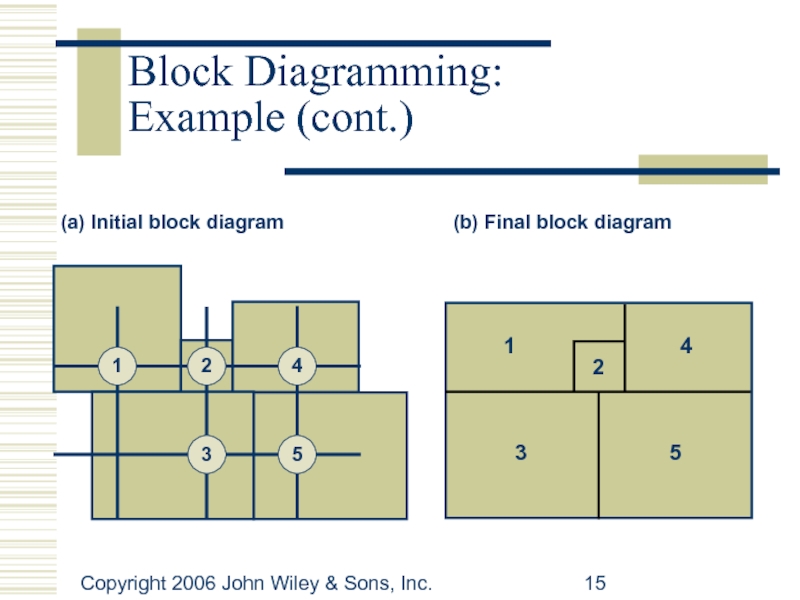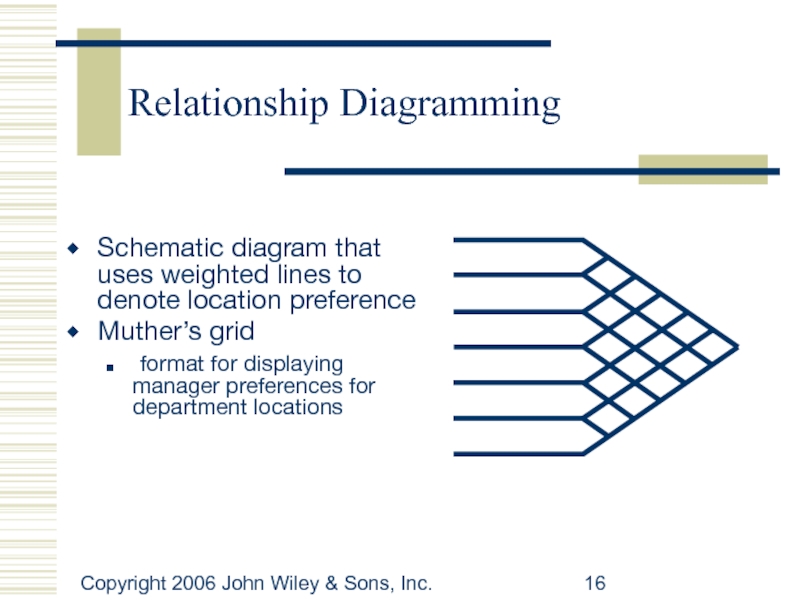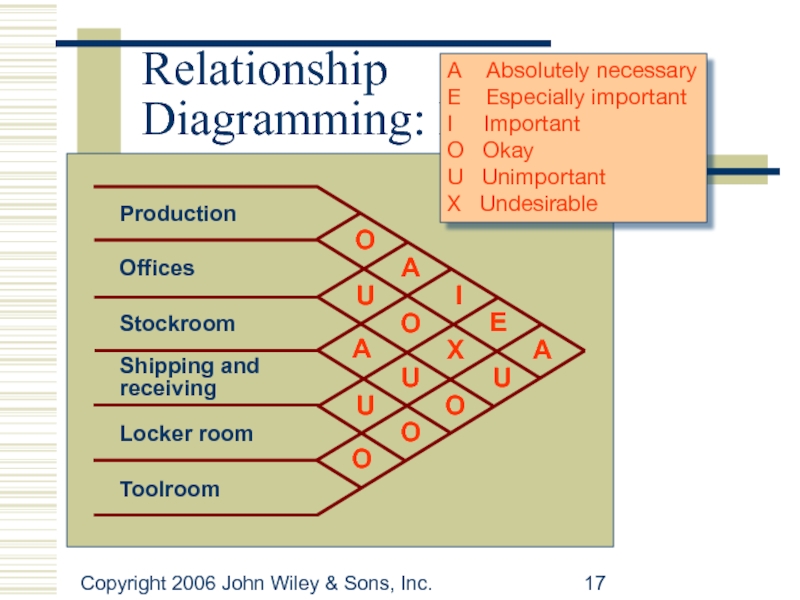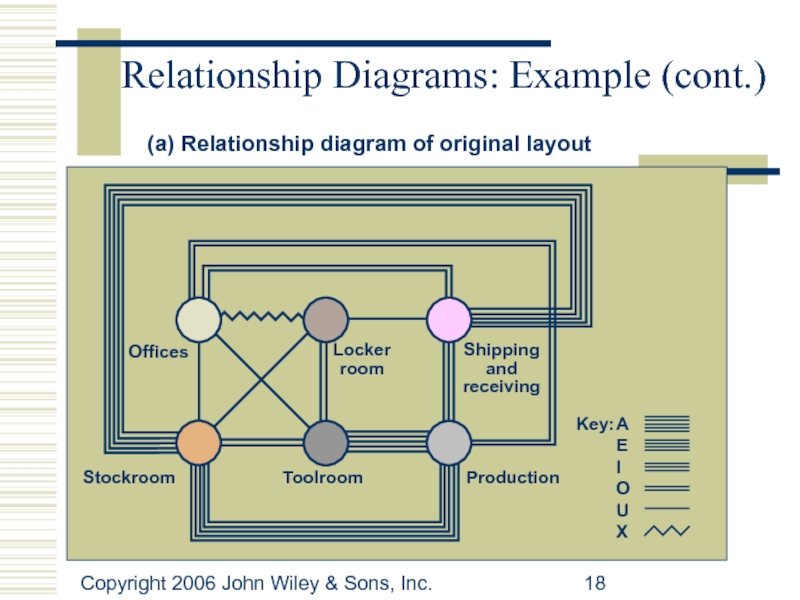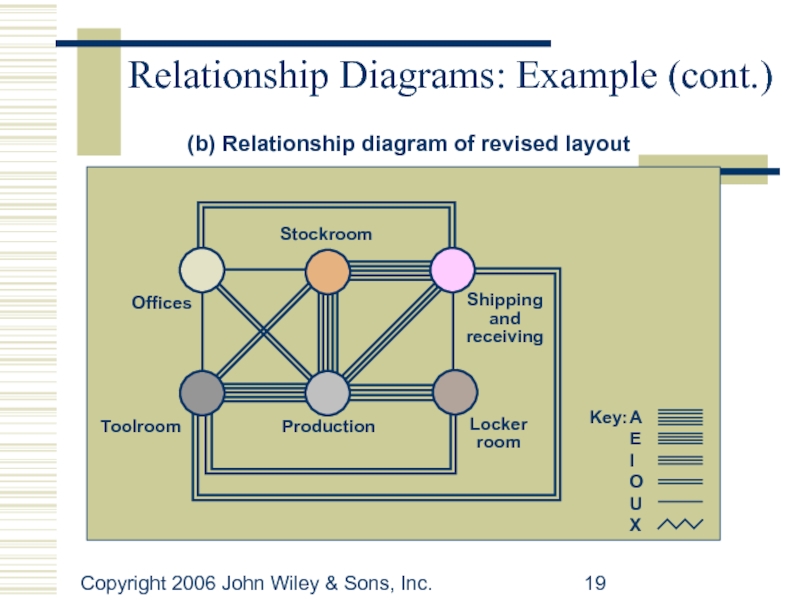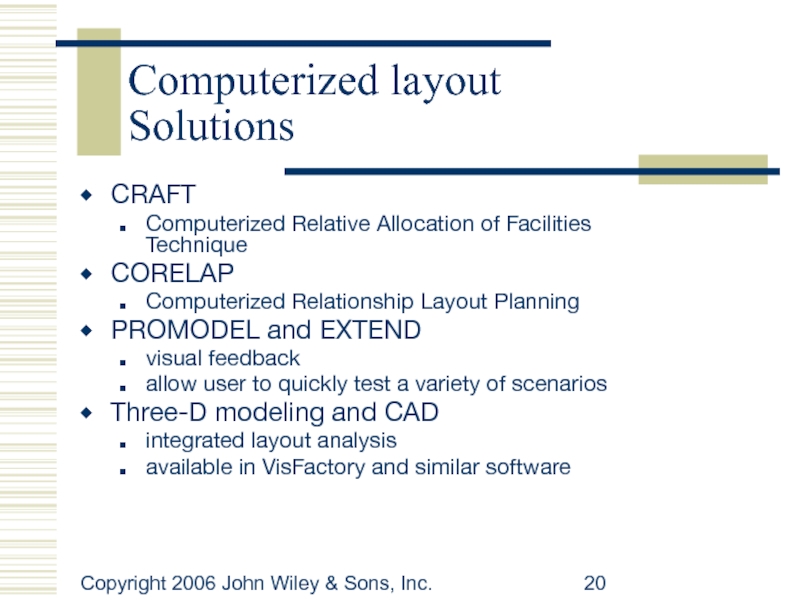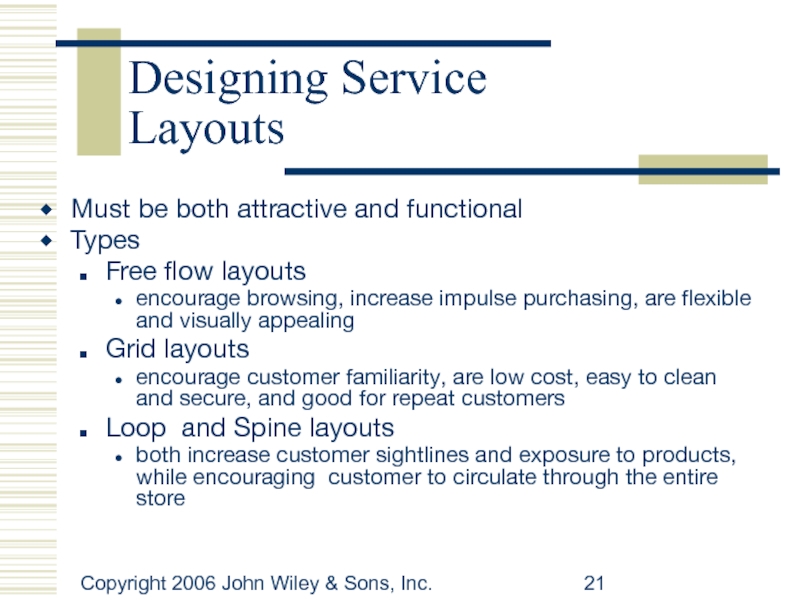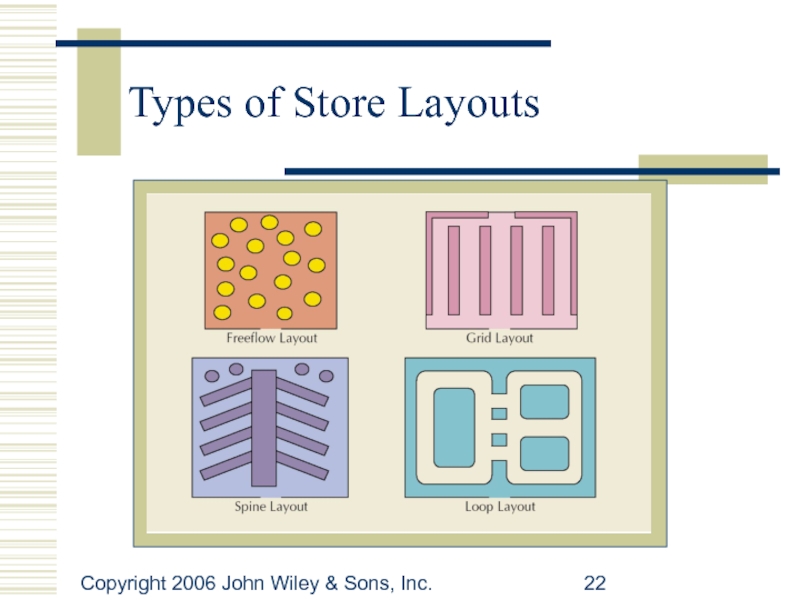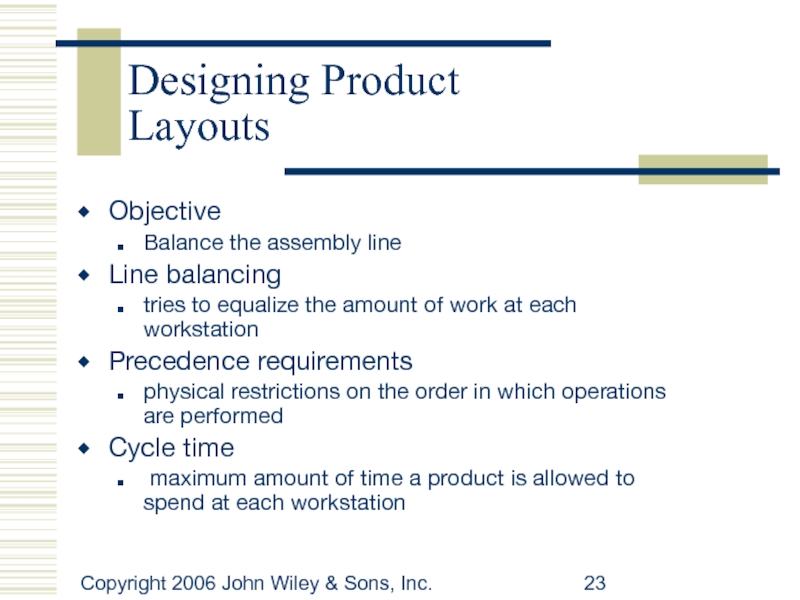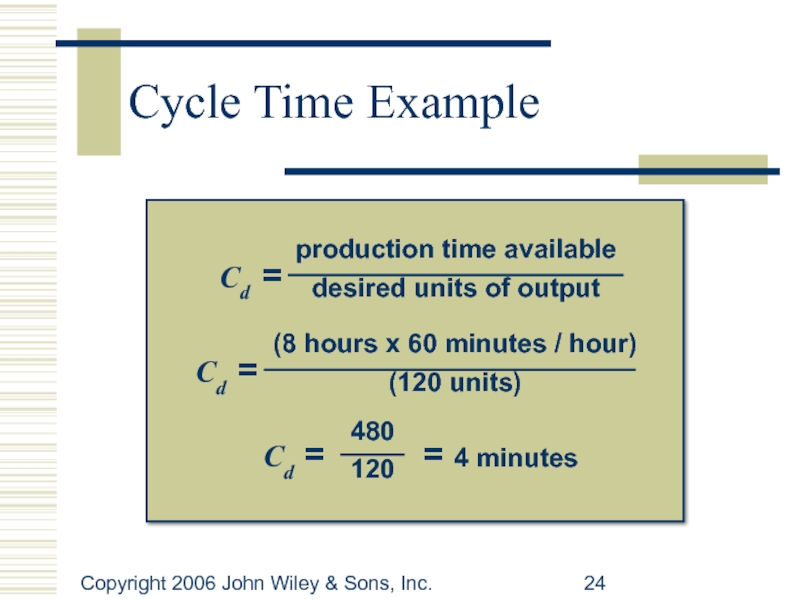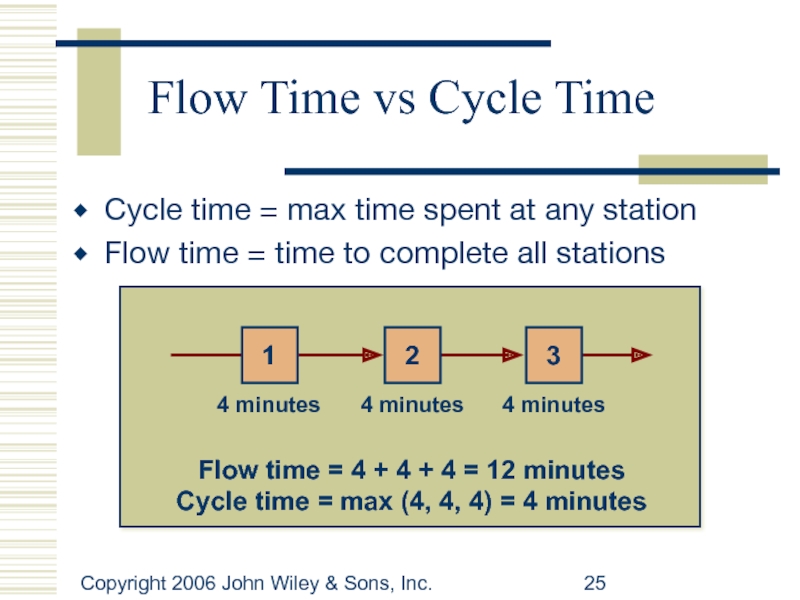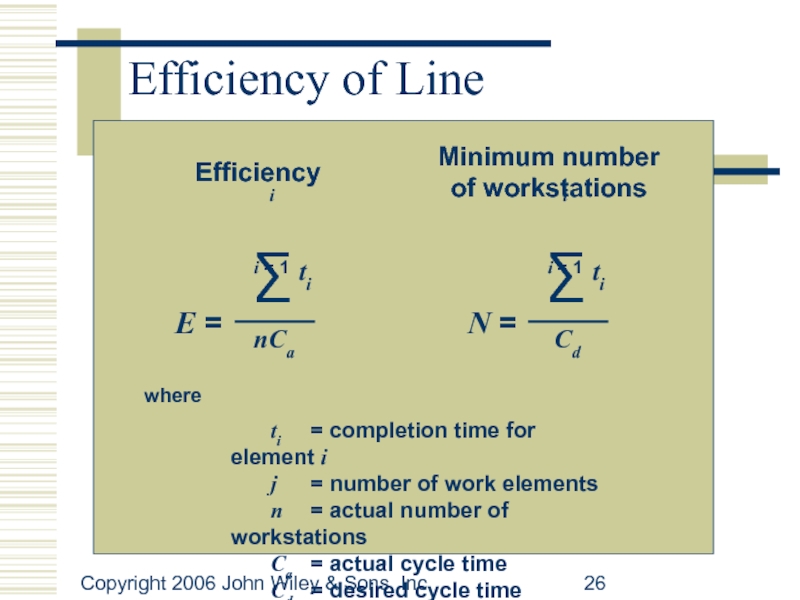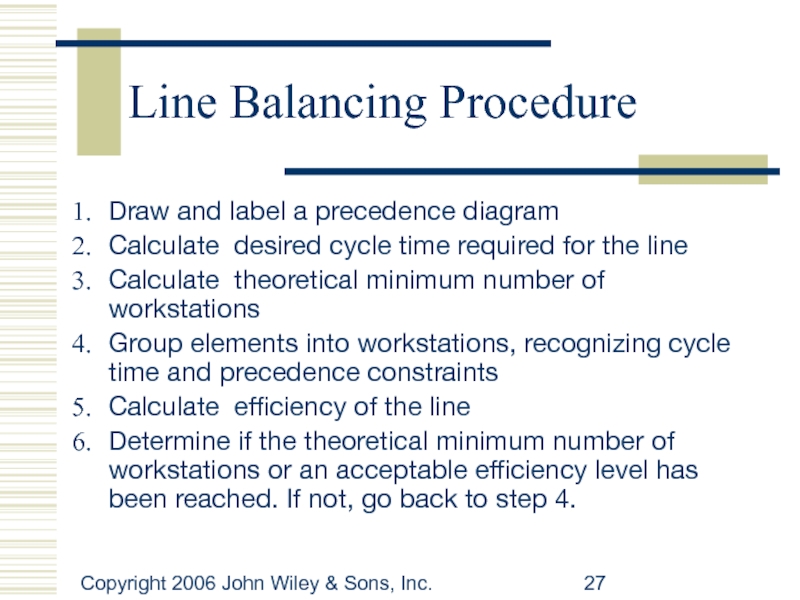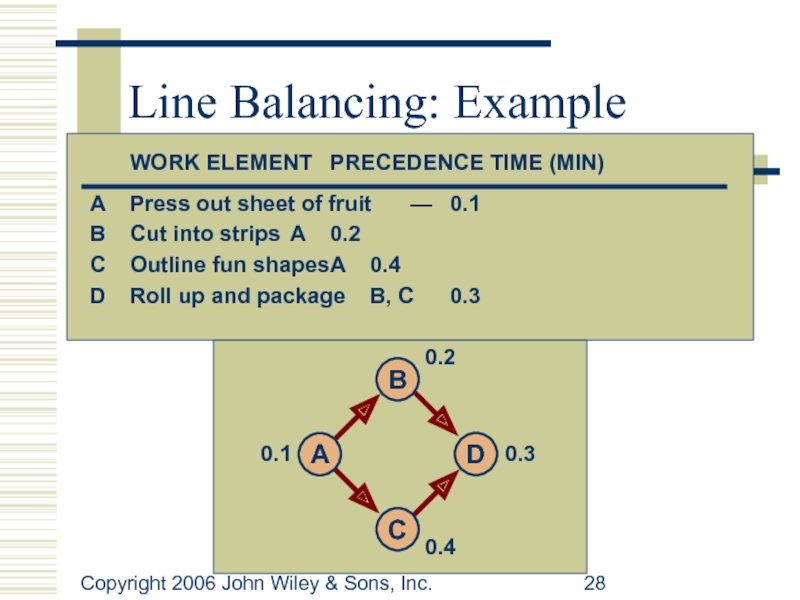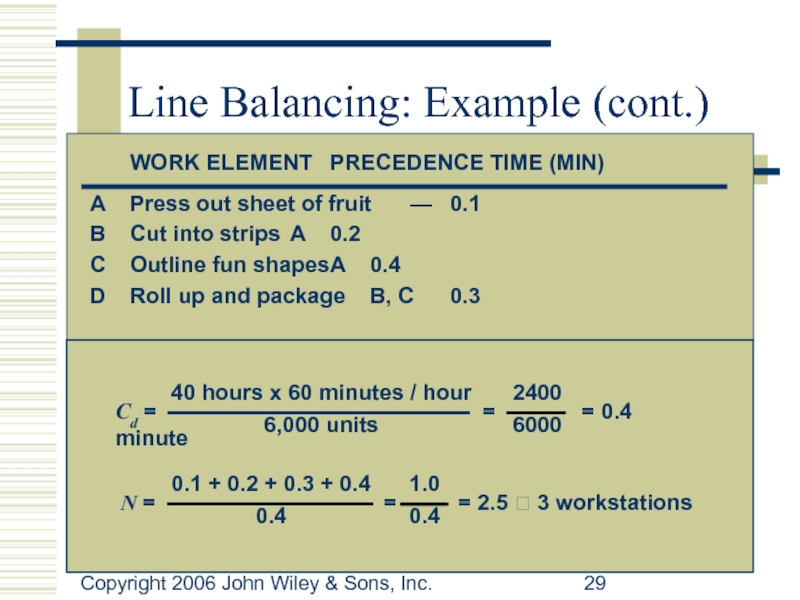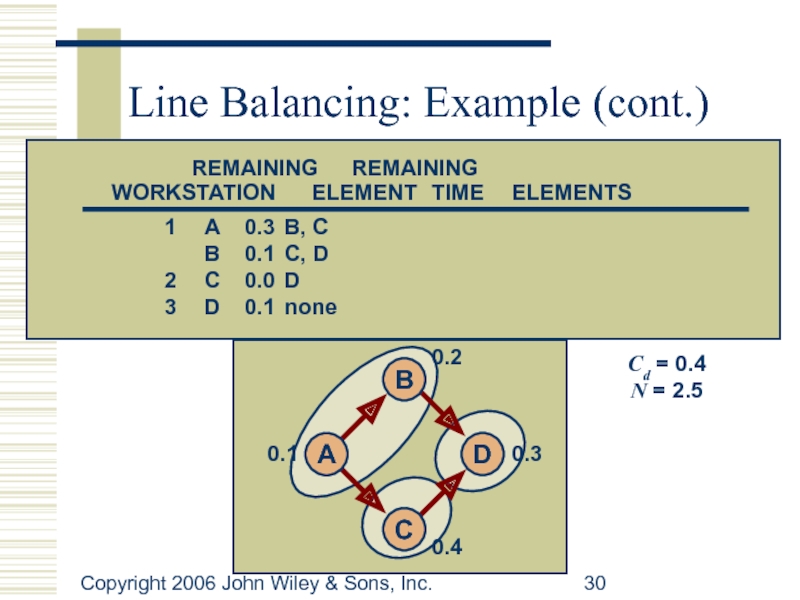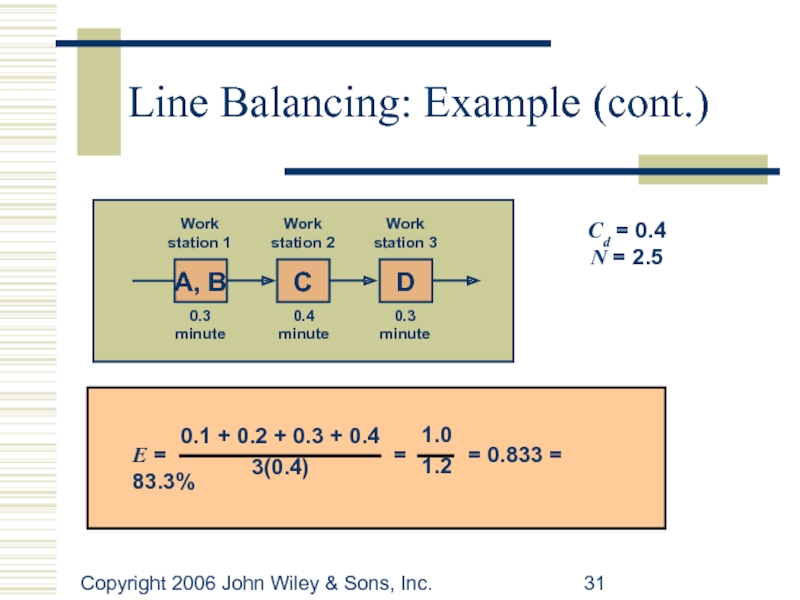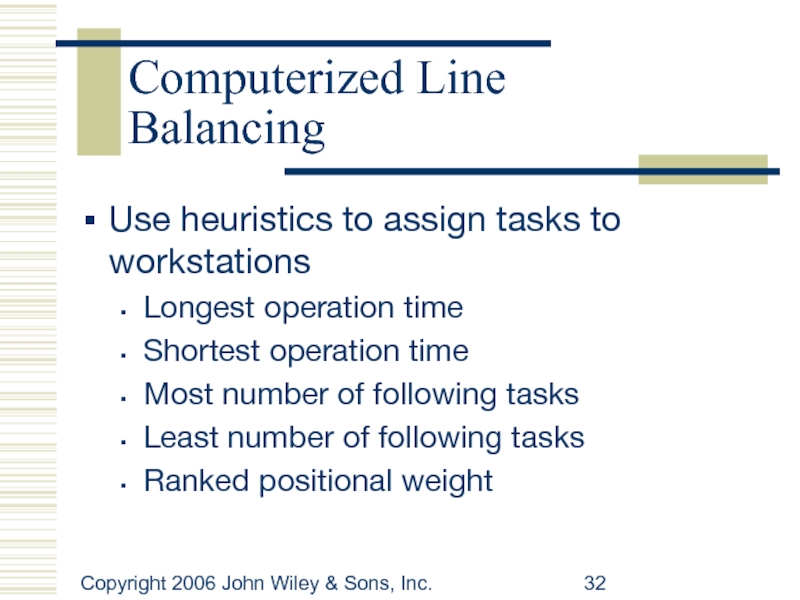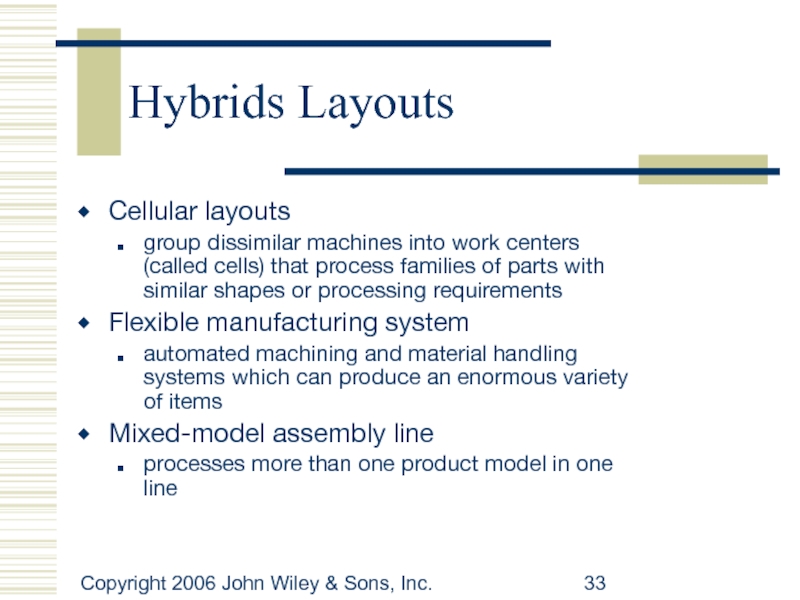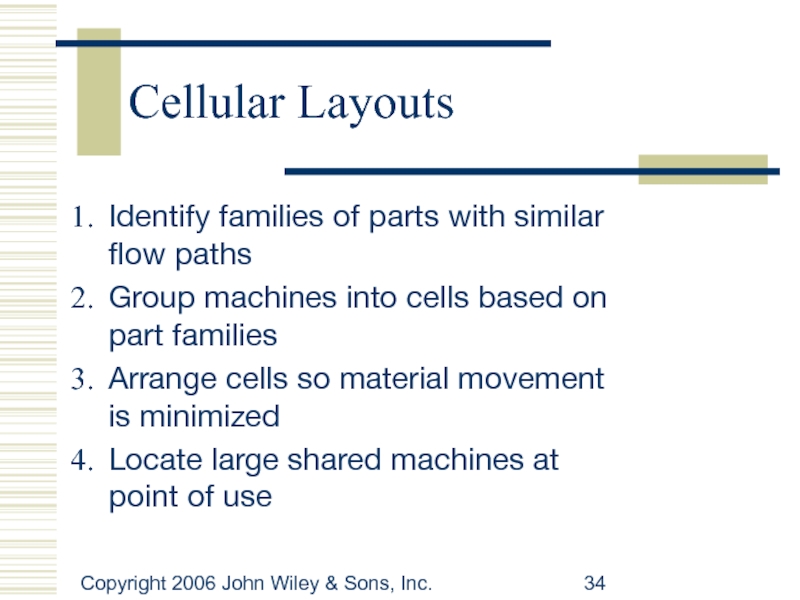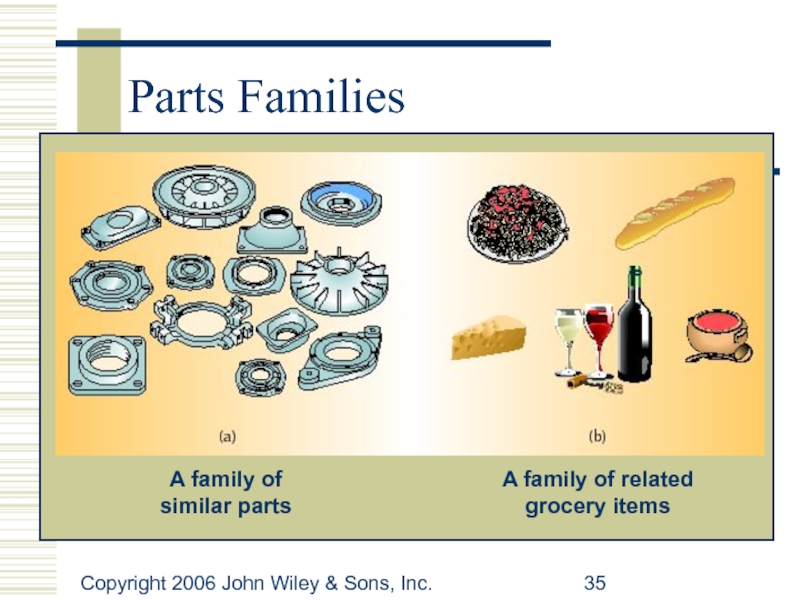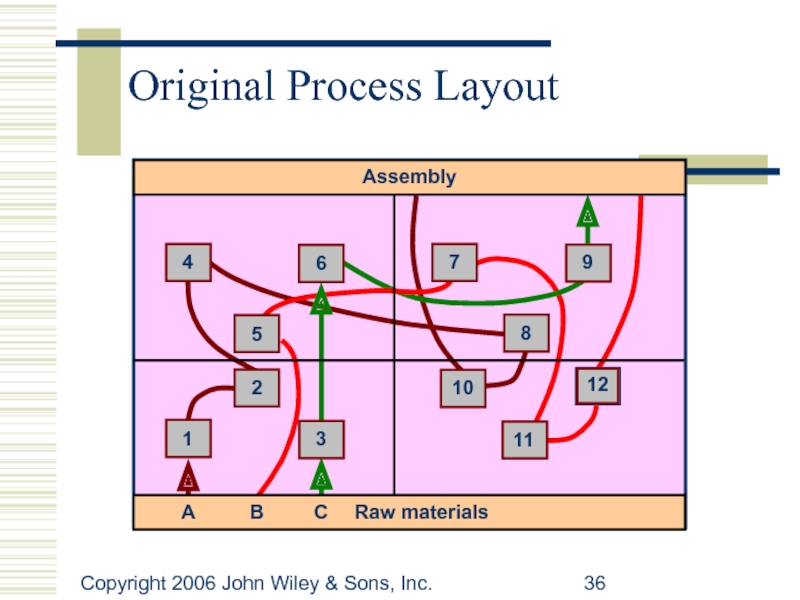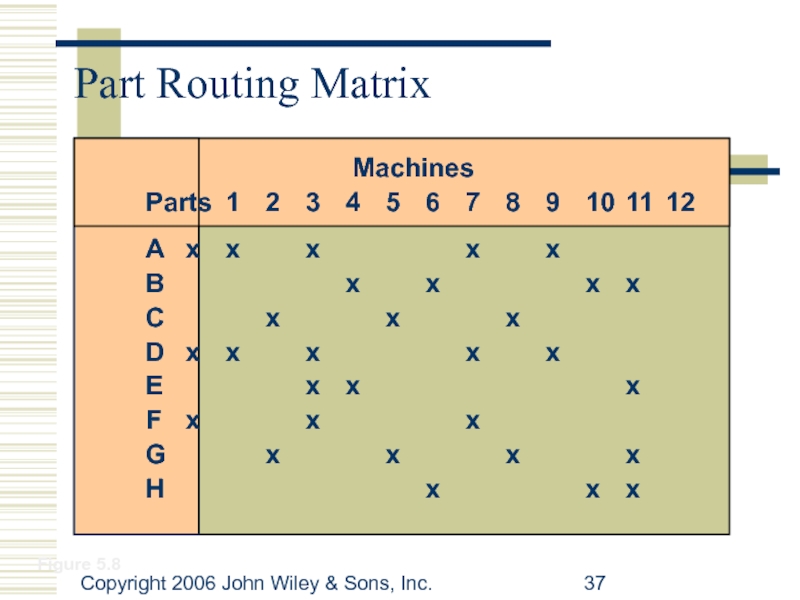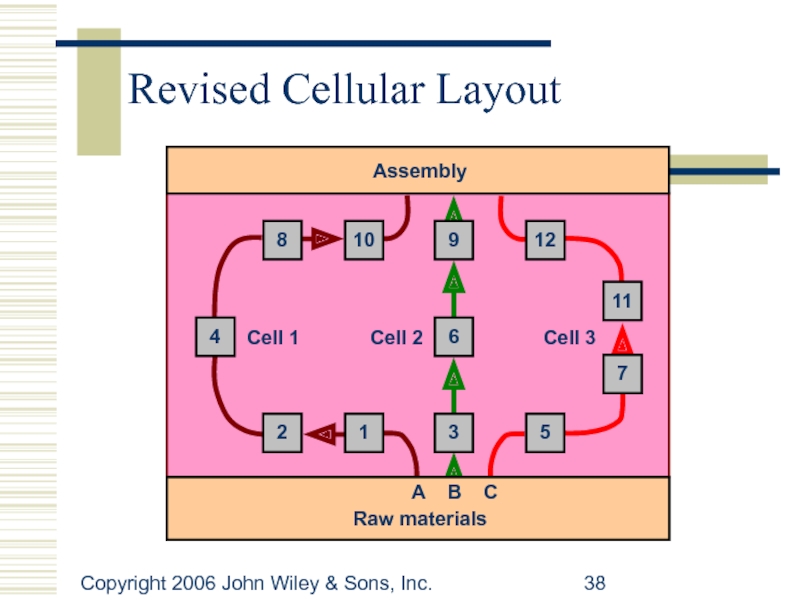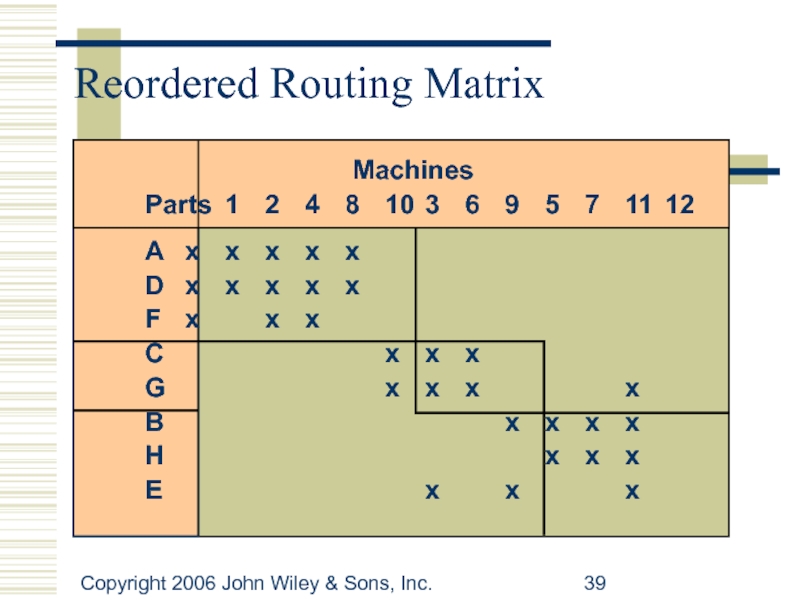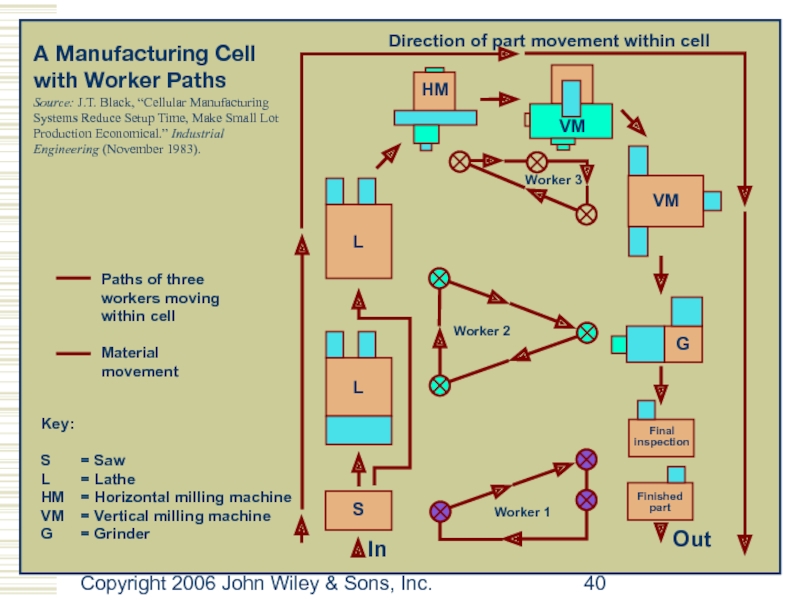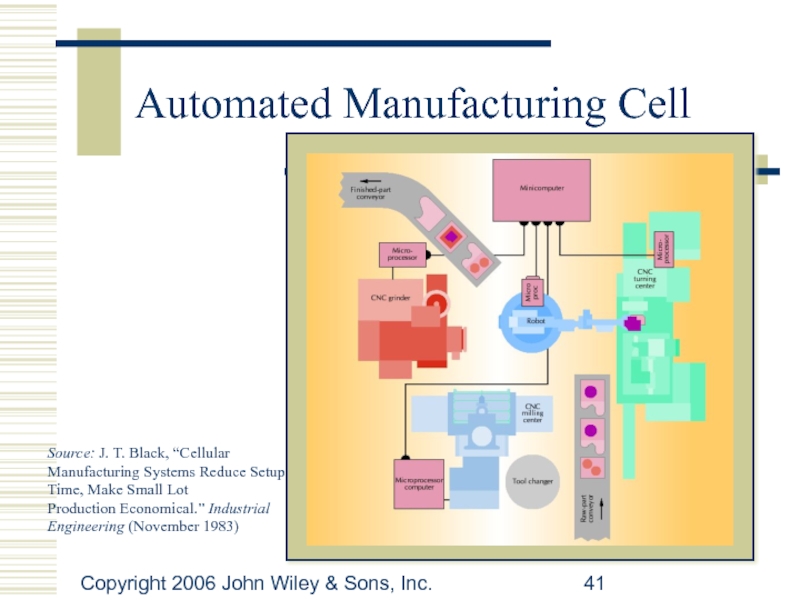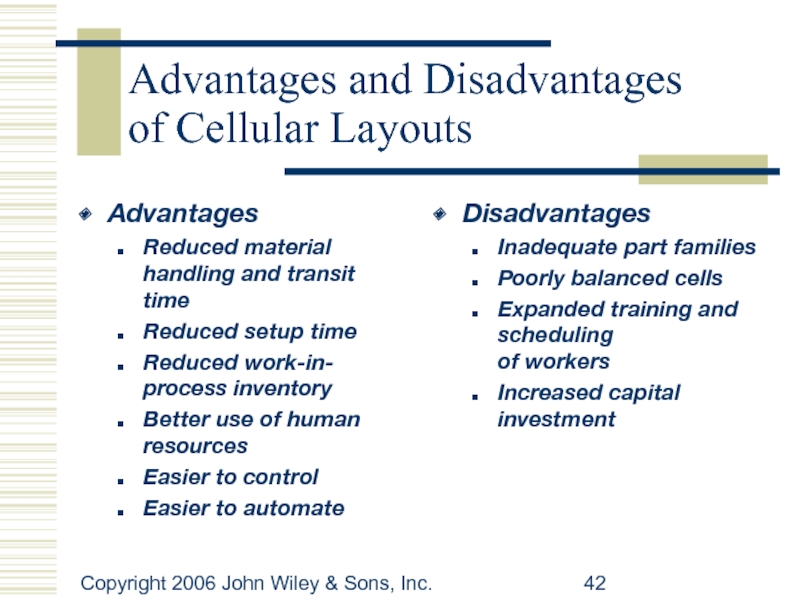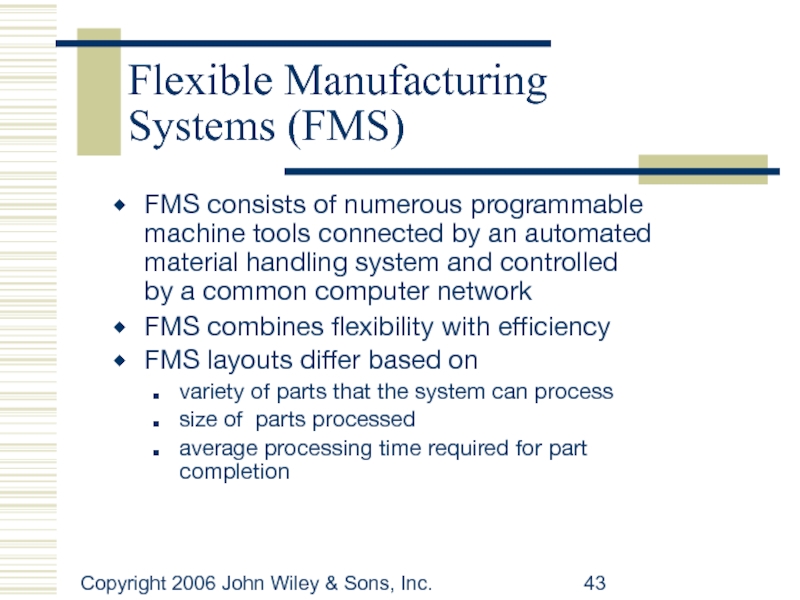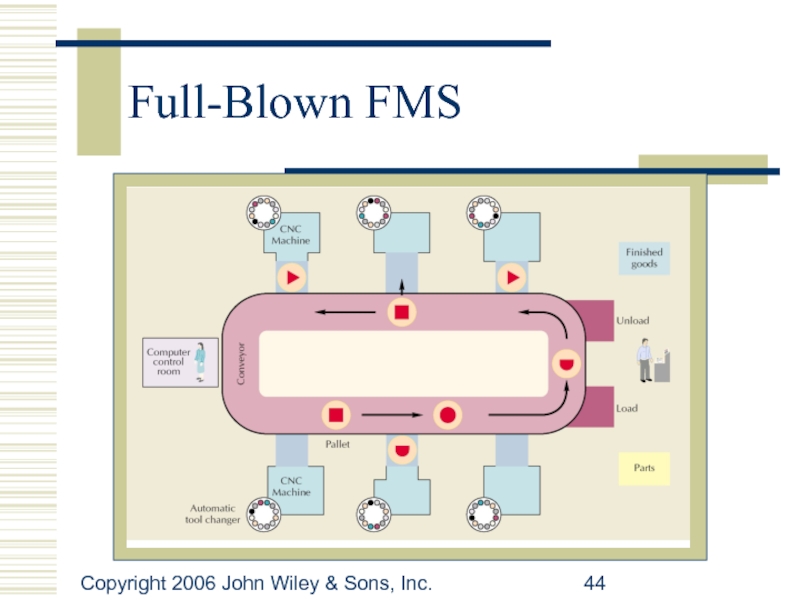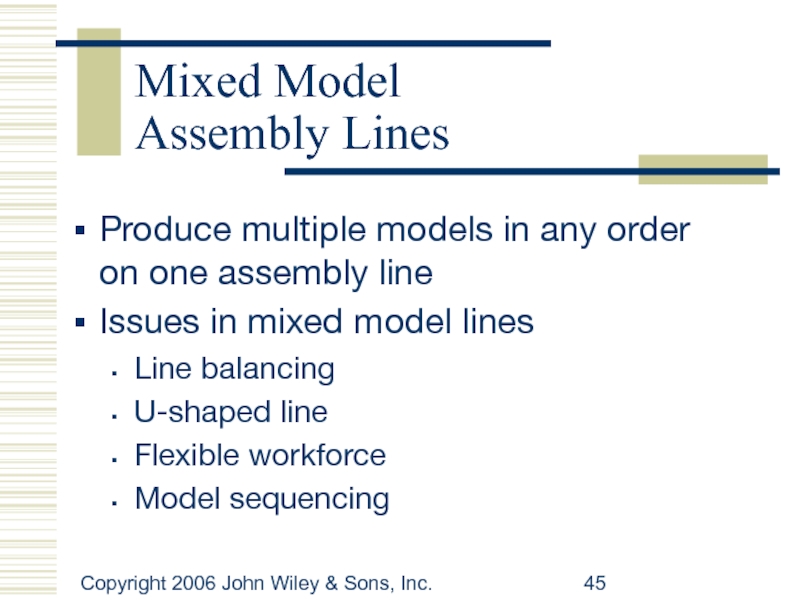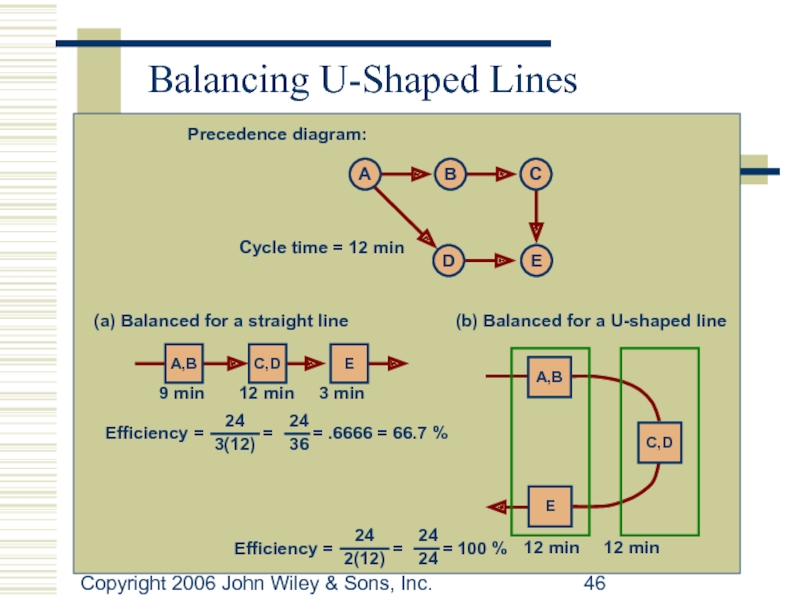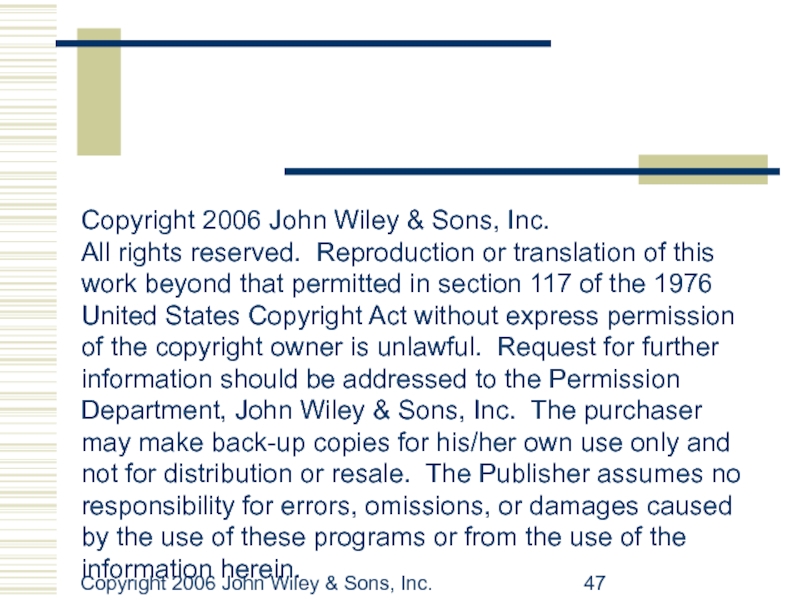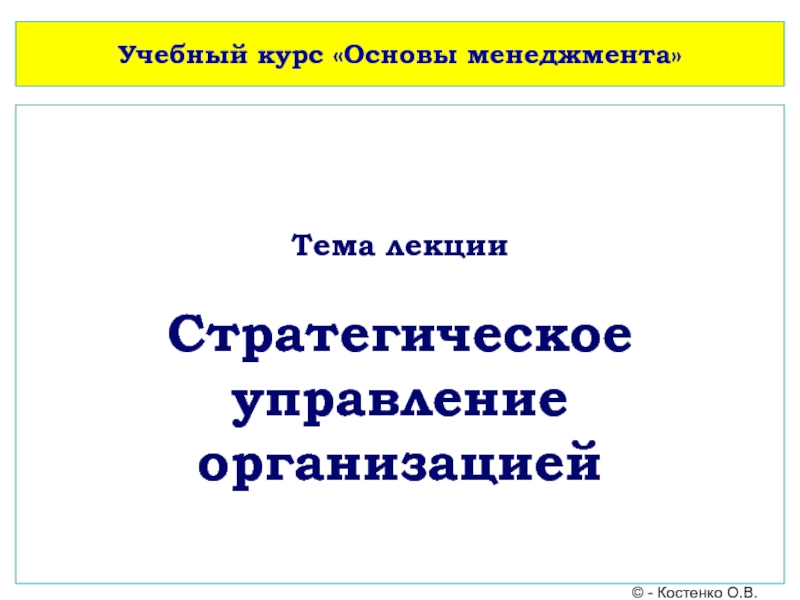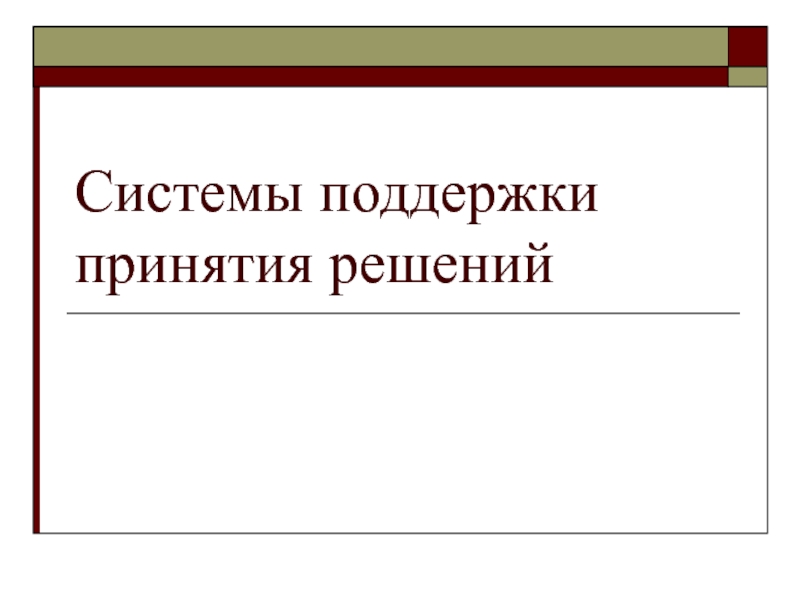- Главная
- Разное
- Дизайн
- Бизнес и предпринимательство
- Аналитика
- Образование
- Развлечения
- Красота и здоровье
- Финансы
- Государство
- Путешествия
- Спорт
- Недвижимость
- Армия
- Графика
- Культурология
- Еда и кулинария
- Лингвистика
- Английский язык
- Астрономия
- Алгебра
- Биология
- География
- Детские презентации
- Информатика
- История
- Литература
- Маркетинг
- Математика
- Медицина
- Менеджмент
- Музыка
- МХК
- Немецкий язык
- ОБЖ
- Обществознание
- Окружающий мир
- Педагогика
- Русский язык
- Технология
- Физика
- Философия
- Химия
- Шаблоны, картинки для презентаций
- Экология
- Экономика
- Юриспруденция
Facility Layout презентация
Содержание
- 1. Facility Layout
- 2. Copyright 2006 John Wiley & Sons, Inc.
- 3. Copyright 2006 John Wiley & Sons, Inc.
- 4. Copyright 2006 John Wiley & Sons, Inc.
- 5. Copyright 2006 John Wiley & Sons, Inc. Process Layout in Services
- 6. Copyright 2006 John Wiley & Sons, Inc.
- 7. Copyright 2006 John Wiley & Sons, Inc. A Product Layout
- 8. Copyright 2006 John Wiley & Sons, Inc.
- 9. Copyright 2006 John Wiley & Sons, Inc.
- 10. Copyright 2006 John Wiley & Sons, Inc.
- 11. Copyright 2006 John Wiley & Sons, Inc.
- 12. Copyright 2006 John Wiley & Sons, Inc.
- 13. Copyright 2006 John Wiley & Sons, Inc. Block Diagramming: Example
- 14. Copyright 2006 John Wiley & Sons, Inc. Block Diagramming: Example (cont.)
- 15. Copyright 2006 John Wiley & Sons, Inc. Block Diagramming: Example (cont.)
- 16. Copyright 2006 John Wiley & Sons, Inc.
- 17. Copyright 2006 John Wiley & Sons, Inc. Relationship Diagramming: Example
- 18. Copyright 2006 John Wiley & Sons, Inc. Relationship Diagrams: Example (cont.)
- 19. Copyright 2006 John Wiley & Sons, Inc. Relationship Diagrams: Example (cont.)
- 20. Copyright 2006 John Wiley & Sons, Inc.
- 21. Copyright 2006 John Wiley & Sons, Inc.
- 22. Copyright 2006 John Wiley & Sons, Inc. Types of Store Layouts
- 23. Copyright 2006 John Wiley & Sons, Inc.
- 24. Copyright 2006 John Wiley & Sons, Inc. Cycle Time Example
- 25. Copyright 2006 John Wiley & Sons, Inc.
- 26. Copyright 2006 John Wiley & Sons, Inc. Efficiency of Line
- 27. Copyright 2006 John Wiley & Sons, Inc.
- 28. Copyright 2006 John Wiley & Sons, Inc. Line Balancing: Example
- 29. Copyright 2006 John Wiley & Sons, Inc. Line Balancing: Example (cont.)
- 30. Copyright 2006 John Wiley & Sons, Inc.
- 31. Copyright 2006 John Wiley & Sons, Inc.
- 32. Copyright 2006 John Wiley & Sons, Inc.
- 33. Copyright 2006 John Wiley & Sons, Inc.
- 34. Copyright 2006 John Wiley & Sons, Inc.
- 35. Copyright 2006 John Wiley & Sons, Inc. Parts Families
- 36. Copyright 2006 John Wiley & Sons, Inc. Original Process Layout
- 37. Copyright 2006 John Wiley & Sons, Inc. Part Routing Matrix Figure 5.8
- 38. Copyright 2006 John Wiley & Sons, Inc. Revised Cellular Layout
- 39. Copyright 2006 John Wiley & Sons, Inc. Reordered Routing Matrix
- 40. Copyright 2006 John Wiley & Sons, Inc.
- 41. Copyright 2006 John Wiley & Sons, Inc. Automated Manufacturing Cell
- 42. Copyright 2006 John Wiley & Sons, Inc.
- 43. Copyright 2006 John Wiley & Sons, Inc.
- 44. Copyright 2006 John Wiley & Sons, Inc. Full-Blown FMS
- 45. Copyright 2006 John Wiley & Sons, Inc.
- 46. Copyright 2006 John Wiley & Sons, Inc. Balancing U-Shaped Lines
- 47. Copyright 2006 John Wiley & Sons, Inc.
Слайд 1Beni Asllani
University of Tennessee at Chattanooga
Facilities
Operations Management - 5th Edition
Chapter 7
Roberta
Слайд 2Copyright 2006 John Wiley & Sons, Inc.
Lecture Outline
Basic Layouts
Designing Process Layouts
Designing
Designing Product Layouts
Hybrid Layouts
Слайд 3Copyright 2006 John Wiley & Sons, Inc.
Facility Layout
Minimize material-handling costs
Utilize space
Utilize labor efficiently
Eliminate bottlenecks
Facilitate communication and interaction
Reduce manufacturing cycle time
Reduce customer service time
Eliminate wasted or redundant movement
Increase capacity
Facilitate entry, exit, and placement of material, products, and people
Incorporate safety and security measures
Promote product and service quality
Encourage proper maintenance activities
Provide a visual control of activities
Provide flexibility to adapt to changing conditions
Arrangement of areas within a facility to:
Слайд 4Copyright 2006 John Wiley & Sons, Inc.
BASIC LAYOUTS
Process layouts
group similar activities
Product layouts
arrange activities in line according to sequence of operations for a particular product or service
Fixed-position layouts
are used for projects in which product cannot be moved
Слайд 8Copyright 2006 John Wiley & Sons, Inc.
Description
Type of process
Product
Demand
Volume
Equipment
Sequential arrangement of
Continuous, mass production, mainly assembly
Standardized, made to stock
Stable
High
Special purpose
Process
Comparison of Product
and Process Layouts
Functional grouping of activities
Intermittent, job shop, batch production, mainly fabrication
Varied, made to order
Fluctuating
Low
General purpose
Product
Слайд 9Copyright 2006 John Wiley & Sons, Inc.
Workers
Inventory
Storage space
Material handling
Aisles
Scheduling
Layout decision
Goal
Advantage
Limited skills
Low
Small
Fixed path (conveyor)
Narrow
Part of balancing
Line balancing
Equalize work at each station
Efficiency
Process
Comparison of Product
and Process Layouts
Varied skills
High in-process, low finished goods
Large
Variable path (forklift)
Wide
Dynamic
Machine location
Minimize material handling cost
Flexibility
Product
Слайд 10Copyright 2006 John Wiley & Sons, Inc.
Fixed-Position Layouts
Typical of projects
Equipment, workers,
Highly skilled labor
Often low fixed
Typically high variable costs
Слайд 11Copyright 2006 John Wiley & Sons, Inc.
Designing Process Layouts
Goal: minimize material
Block Diagramming
minimize nonadjacent loads
use when quantitative data is available
Relationship Diagramming
based on location preference between areas
use when quantitative data is not available
Слайд 12Copyright 2006 John Wiley & Sons, Inc.
Block Diagramming
Unit load
quantity in
Nonadjacent load
distance farther than the next block
STEPS
create load summary chart
calculate composite (two way) movements
develop trial layouts minimizing number of nonadjacent loads
Слайд 16Copyright 2006 John Wiley & Sons, Inc.
Relationship Diagramming
Schematic diagram that uses
Muther’s grid
format for displaying manager preferences for department locations
Слайд 20Copyright 2006 John Wiley & Sons, Inc.
Computerized layout Solutions
CRAFT
Computerized Relative Allocation
CORELAP
Computerized Relationship Layout Planning
PROMODEL and EXTEND
visual feedback
allow user to quickly test a variety of scenarios
Three-D modeling and CAD
integrated layout analysis
available in VisFactory and similar software
Слайд 21Copyright 2006 John Wiley & Sons, Inc.
Designing Service Layouts
Must be both
Types
Free flow layouts
encourage browsing, increase impulse purchasing, are flexible and visually appealing
Grid layouts
encourage customer familiarity, are low cost, easy to clean and secure, and good for repeat customers
Loop and Spine layouts
both increase customer sightlines and exposure to products, while encouraging customer to circulate through the entire store
Слайд 23Copyright 2006 John Wiley & Sons, Inc.
Designing Product Layouts
Objective
Balance the assembly
Line balancing
tries to equalize the amount of work at each workstation
Precedence requirements
physical restrictions on the order in which operations are performed
Cycle time
maximum amount of time a product is allowed to spend at each workstation
Слайд 25Copyright 2006 John Wiley & Sons, Inc.
Flow Time vs Cycle Time
Cycle
Flow time = time to complete all stations
Слайд 27Copyright 2006 John Wiley & Sons, Inc.
Line Balancing Procedure
Draw and label
Calculate desired cycle time required for the line
Calculate theoretical minimum number of workstations
Group elements into workstations, recognizing cycle time and precedence constraints
Calculate efficiency of the line
Determine if the theoretical minimum number of workstations or an acceptable efficiency level has been reached. If not, go back to step 4.
Слайд 30Copyright 2006 John Wiley & Sons, Inc.
Line Balancing: Example (cont.)
Cd =
N = 2.5
REMAINING REMAINING
WORKSTATION ELEMENT TIME ELEMENTS
1 A 0.3 B, C
B 0.1 C, D
2 C 0.0 D
3 D 0.1 none
Слайд 32Copyright 2006 John Wiley & Sons, Inc.
Computerized Line Balancing
Use heuristics to
Longest operation time
Shortest operation time
Most number of following tasks
Least number of following tasks
Ranked positional weight
Слайд 33Copyright 2006 John Wiley & Sons, Inc.
Hybrids Layouts
Cellular layouts
group dissimilar machines
Flexible manufacturing system
automated machining and material handling systems which can produce an enormous variety of items
Mixed-model assembly line
processes more than one product model in one line
Слайд 34Copyright 2006 John Wiley & Sons, Inc.
Cellular Layouts
Identify families of parts
Group machines into cells based on part families
Arrange cells so material movement is minimized
Locate large shared machines at point of use
Слайд 42Copyright 2006 John Wiley & Sons, Inc.
Advantages and Disadvantages
of Cellular
Advantages
Reduced material handling and transit time
Reduced setup time
Reduced work-in- process inventory
Better use of human resources
Easier to control
Easier to automate
Disadvantages
Inadequate part families
Poorly balanced cells
Expanded training and scheduling
of workers
Increased capital investment
Слайд 43Copyright 2006 John Wiley & Sons, Inc.
Flexible Manufacturing Systems (FMS)
FMS consists
FMS combines flexibility with efficiency
FMS layouts differ based on
variety of parts that the system can process
size of parts processed
average processing time required for part completion
Слайд 45Copyright 2006 John Wiley & Sons, Inc.
Mixed Model
Assembly Lines
Produce multiple
Issues in mixed model lines
Line balancing
U-shaped line
Flexible workforce
Model sequencing
